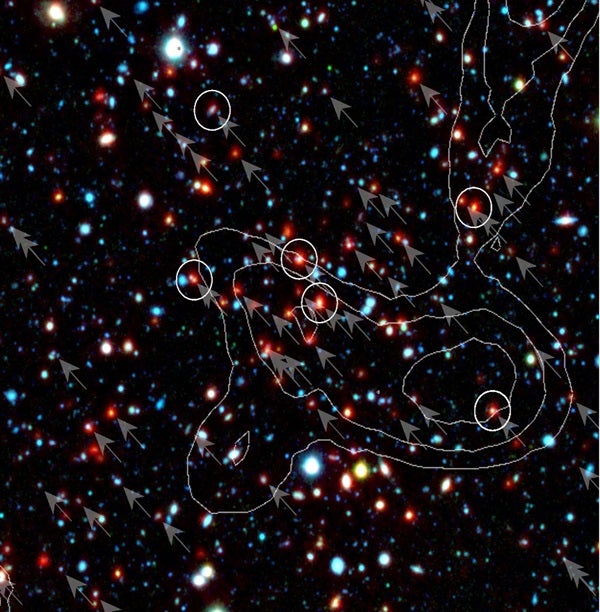Masayuki Tanaka of the Institute for the Physics and Mathematics of the Universe (IPMU) in Tokyo, Alexis Finoguenov of the Max Planck Institute for Extraterrestrial Physics in Garching, Germany, and Yoshihiro Ueda of Kyoto University in Japan discovered the most distant cluster of galaxies in the universe, 9.6 billion light-years away, using light invisible to our eyes.
The universe hosts a multitude of galaxies that are not uniformly distributed in the universe, but they are arrayed in filamentary structures. Filaments permeate the universe and form a gigantic cosmic spider web. Galaxy clusters are often located at the knots of the filaments. The most distant cluster known, at least until now, is located about 9.2 billion light-years away. A team of astronomers from Japan and Germany has discovered an even more distant cluster of galaxies using light invisible to human eyes.
The universe is a time machine — you can go back in time as you look deeper into the universe. Astronomers have used this principle in search of clusters that are in the distant past. But the expansion of the universe forces distant galaxies away from Earth at high velocities, shifting their light away from visible wavelengths to infrared wavelengths. This shift makes the light from the distant universe invisible, which has impeded progress over the years. The powerful capability of Subaru’s near-infrared eye, the Multi-Object InfraRed Camera and Spectrograph (MOIRCS), now enables astronomers to peer deeper into the early universe.
Tanaka and collaborators found a distant cluster of galaxies in the constellation Cetus. MOIRCS was used to measure the distances to massive galaxies in the cluster. “MOIRCS has an extremely powerful capability of measuring distances to galaxies,” said Tanaka. “This is what made our challenging observation possible.” The team succeeded in measuring the distances and confirmed that several galaxies actually have congregated at a distance as far as 9.6 billion light-years away. “Though we confirmed only several massive galaxies at that distance,” Tanaka said, “there is convincing evidence that the cluster is a real gravitationally bound cluster.”
Galaxy clusters host a vast amount of matter heated to extreme temperatures. Every material emits light, but at such high temperatures, the emission is so blue that the light is not visible to the human eye. The team used the orbiting X-ray observatory XMM-Newton to search for invisible light from the cluster. “Despite the difficulties in collecting X-ray photons with a small, effective telescope, size similar to the size of a backyard telescope,” Finoguenov said, “we detected a clear signature of hot gas in the cluster.”
The combination of observations in invisible wavelengths, near-infrared, and X-ray has led to the discovery of the cluster at 9.6 billion light-years away, making it the most distant cluster known today, some 400 million more light-years away than the previous record-holder. The cluster is an ideal laboratory for studying the evolution of galaxies. Also, a collection of such distant clusters can be a sensitive probe of the origin of the universe. The team is continuing their search for still more distant clusters.










